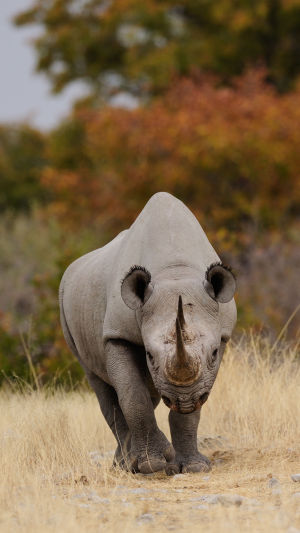The seemingly clumsy rhino is actually very popular, whether it is the anime "Digimon" that swept across Asia, or the popular movie "Zootopia" all over the world, it has appeared. But such a slow-looking giant creature has many little secrets.
Rhinos are currently the second largest animals on land after elephants, with a body length of nearly 5 meters and a weight of up to 6 tons, but a height of no more than 2 meters and a lifespan of about 50 years. Female rhinos breed once every 4-5 years, each pregnancy is 18 months and can only give birth to one child. The baby rhinos will live with their mothers for about three years before they can live independently. Therefore, the female rhinos will wait for the child to leave her before considering the next birth.
Male rhinos are territorial. In order to protect their territory, they are not afraid of lions, tigers, leopards and other creatures on the grasslands. To some extent, their androgen levels can be stimulated. Male rhinos that have been kept in captivity for a long time will lose their territorial awareness, and female rhinos will suffer from uterine problems that affect their reproductive ability and are eventually sterilized. Rhinos mostly live alone, with little contact between individuals. Only white rhinos live in groups of about 10 and avoid humans most of the time. However, male rhinos during the mating period and female rhinos that are feeding young rhinos are easily stimulated and should not take the initiative to provoke them.
Despite their bulky size, they can walk or run at considerable speed, even in dense, thorny forests. For example, African black rhinos can reach speeds of 45 kilometers per hour in short distances, so adult rhinos have no enemies other than humans. The popular mud baths all over the world are derived from animals such as rhinos. Rhinos will use natural resources such as swamps and sludge to repair wounds and eliminate skin diseases. Humans, on the other hand, transfer chemical elements, microorganisms and other active ingredients to the human body through the heat energy of the mud bath, so as to achieve the effect of fitness and disease prevention.
Rhinos often have ox starlings on their bodies, which will peck at lice, ticks, and maggots on rhinos. A single rhino can eat up to 100 blood-sucking lice and 13,000 larvae a day, alerting rhinos when large predators approach them. But if there is a wound on the rhino, the starling will widen the wound and prevent it from healing, allowing them to feed on blood for a long time.
Rhinos have a very special sleeping position, they sometimes lie down, sometimes they fall asleep standing up. They snort and squeal when they are excited. There are 5 species of rhinos in the world, namely white rhino and black rhino in Africa, Indian rhino, Java rhino and Sumatran rhino in Asia. All rhinos except black rhino are endangered. There is not much difference in color between white rhino and black rhino, just because they were named by the Dutch in the early days, and later because of the English translation error, the current name misleads the world.





